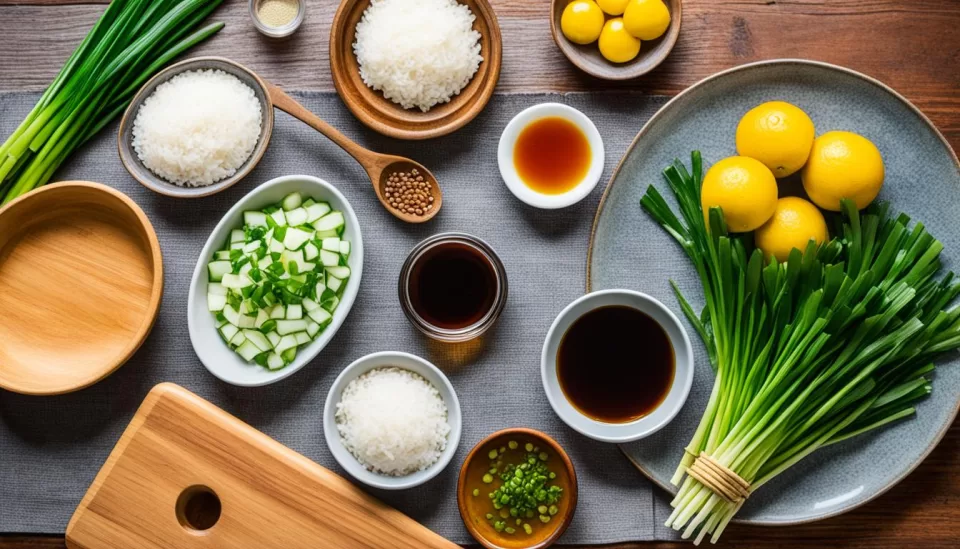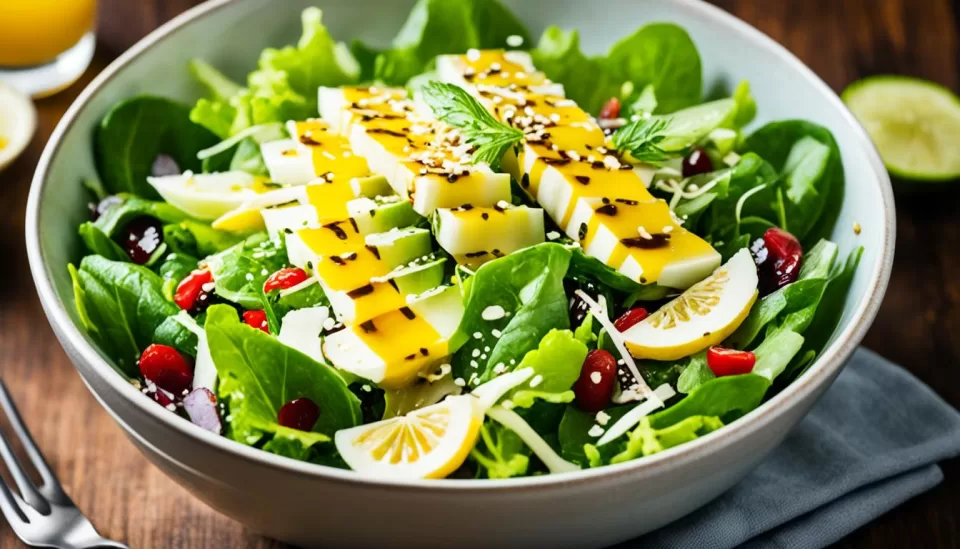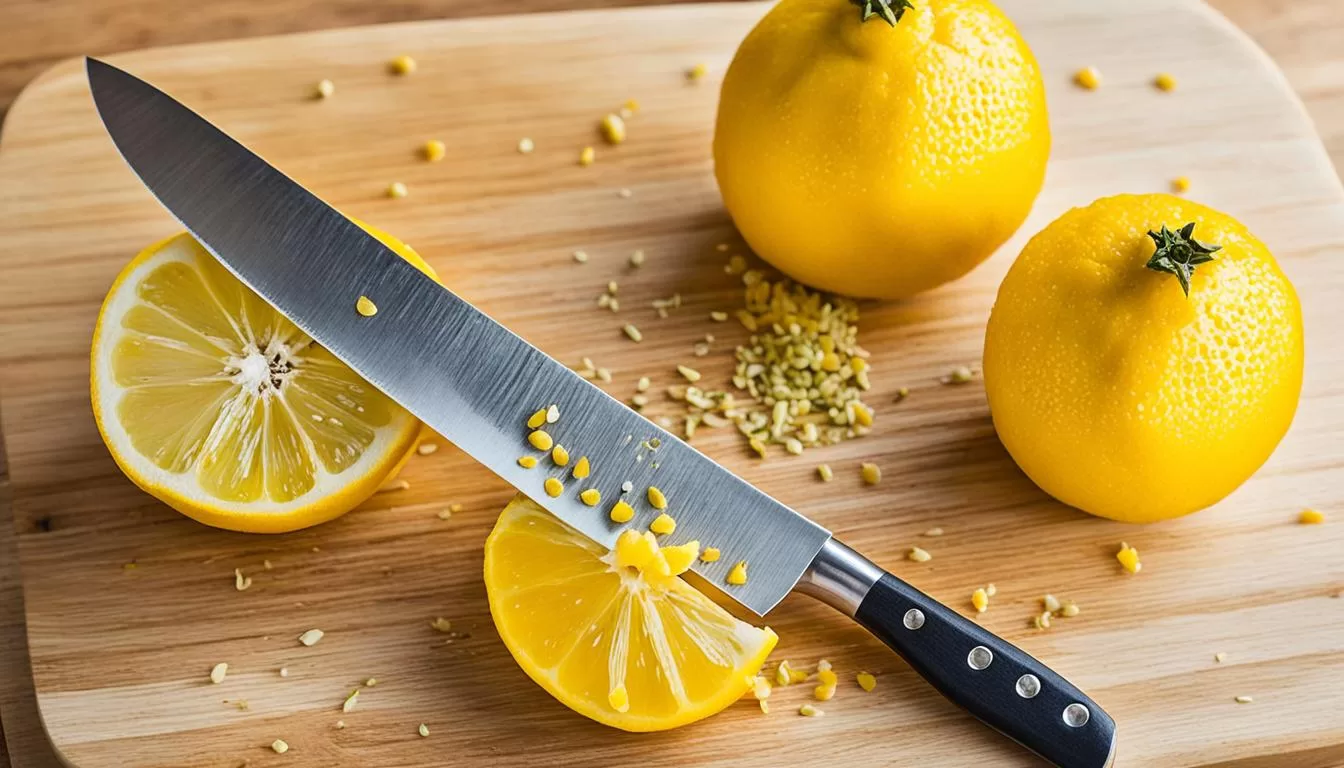Have you ever experienced the vibrant flavors of authentic Yuzu ponzu sauce? This traditional Japanese citrus sauce will captivate your taste buds with its complexity and freshness. Typically found in the heart of Japan’s winter cuisine, yuzu offers a balance of tangy zest and floral aroma that cannot be found in any other citrus. By learning to make your own homemade ponzu sauce, you unlock the door to a world of rich flavors, elevating your culinary creations from ordinary to extraordinary.
One cannot overstate the satisfaction that comes with crafting a ponzu sauce recipe from scratch. The homemade version outshines store-bought not only in taste but also in its ability to connect you to the essence of Japanese cooking traditions. Your kitchen is the beginning of a delectable journey through the nuances of yuzu, renowned for its integral role in dishes that foster warmth and comfort during the cooler seasons. Ready to immerse yourself in the process? Let’s unveil the secrets to making your own yuzu ponzu sauce at home.
Exploring the Origins of Yuzu Ponzu Sauce
Discovering the rich history of yuzu ponzu sauce is like embarking on a culinary journey to Edo Period Japan. Here, generations have cherished the authentic ponzu sauce, a testament to Japan’s profound culinary traditions. But what is the story behind this beloved condiment? Let’s delve into the vibrant past of ponzu sauce, uncovering the remarkable influences that shaped its unique flavor profile and cemented its role in Japanese cuisine.
Tracing the Sauce’s Roots from Edo Period Japan
The tale of yuzu ponzu begins in a Japan that was largely secluded from the world, with Edo Period Japan fostering a distinctive culture and cuisine in its relative isolation. The saga of ponzu is deeply rooted in these times, revealing how indigenous culinary practices embraced the aromatic yuzu, a citrus fruit that would become a cornerstone of Japanese flavor.
Influence of Dutch Cuisine and the Evolution of Ponzu
Despite its seclusion, Japan did not evolve in total solitude. The historic port of Nagasaki served as a conduit for Dutch settlers, bringing with them their own language and culinary nuances. Among their contributions was the concept of ‘pon’, a word implying punch, which paired with ‘su’—the Japanese word for vinegar—gave rise to the term ponzu. It was this cross-pollination of Dutch cuisine influence and local Japanese ingredients that transformed a simple citrus-vinegar mix into the ponzu dipping sauce history celebrates today.
The blending of these global tastes with local delicacies was pivotal. Osakan merchants, with their innovative spirit, began using this citrus-spiked sauce to enhance the flavors of fish—introducing the ponzu sauce to a wider audience. In time, this fusion of East and West would evolve further, and by the mid-20th century, ponzu had become an iconic condiment available not only in the Osaka region but also around the globe.
Crafting the Perfect Yuzu Ponzu Sauce
Embarking on the journey of creating your own Yuzu Ponzu Sauce is an adventure into traditional Japanese cuisine. This citrus soy sauce brings together unique ingredients that reflect the authenticity and depth of flavors one expects from a classic Japanese dipping sauce. Before we dive into crafting this exquisite condiment, let’s ensure we have all the necessary components to capture the essence of a true ponzu sauce recipe.
Essential Ingredients for Authentic Flavors
Your quest to make the perfect yuzu ponzu dressing begins with gathering high-quality, traditional ingredients. Central to this recipe is fresh yuzu juice, which provides an irreplaceable tart and aromatic essence. Complement this with the savory depth of soy sauce, the subtle sweetness of mirin, and the umami-rich flavors of katsuobushi and kombu, and you’re well on your way to ponzu perfection. Here’s what you’ll need:
- Fresh yuzu fruits (at least 5)
- Soy sauce
- Hon mirin (for its higher alcohol content)
- Katsuobushi (dried bonito flakes)
- Kombu (edible kelp)
Manufacturing a traditional yuzu ponzu dressing at home involves more than just mixing ingredients; it is a labor of love that calls for meticulousness and a respect for the culinary arts.
Step by Step Tutorial on Making Yuzu Ponzu at Home
To create your authentic ponzu sauce recipe, follow these steps, ensuring each is done with care and precision. Embrace the art of Japanese cooking as you prepare this superb dressing:
- Clean and sterilize a wide-mouth jar, large enough to hold all the ingredients.
- Add the combined yuzu juice, soy sauce, mirin, katsuobushi, and kombu to the jar.
- Ensure all ingredients are fully submerged, then seal the jar and allow it to steep in the refrigerator for a full 24 hours to let the flavors meld.
- Strain the mixture using a fine-mesh sieve to remove the solid ingredients, retaining the liquid gold that is your homemade ponzu.
Patience and precision are the keys to unlocking the rich, balanced flavors that make yuzu ponzu dressing not just a sauce, but an experience.
Key Differences from Traditional Recipes for Extra Flavor
While traditional recipes may opt for lower-grade mirin with preservatives, our ponzu sauce recipe stands out by using hon mirin, a crucial variation that not only honors authenticity but also heightens the flavor profile significantly. This dedication to quality ingredients results in a more vibrant, nuanced yuzu ponzu that will unquestionably enhance your dishes. Remember, the unique combination of flavors within your ponzu reflects the care and precision you’ve invested in the cooking process.

Now that you’ve mastered the craft of making yuzu ponzu sauce, you will discover its dynamic ability to transform any meal with just a drizzle. Whether as an accompaniment to sushi or a vivacious dressing for salads, the citrusy undertones and umami character of your homemade ponzu will invariably impress and satisfy.
The Role of Yuzu in Japanese Cuisine
As you delve into the world of traditional Japanese flavors, you’ll soon recognize the quintessential role of the Japanese citrus fruit, yuzu. Its remarkable yuzu flavor profile is at the heart of many dishes, accrediting it as a Japanese culinary staple. This winter fruit, with its refreshingly tart taste and highly aromatic zest, enriches a variety of recipes, making it an invaluable component in the culinary arts of Japan.
Relatively unknown in Western kitchens as a fresh ingredient, yuzu is celebrated in Japan primarily for its zest and juice. Similar to Western uses of lemon, yuzu’s zest brings a bright, sharp accent to dishes, while its juice imparts a unique combination of sweet, sour, and umami flavors, elevating them to new levels of taste complexity.
Inherent to its cultural significance, yuzu is more than just a flavor enhancer; it embodies a seasonal delight, embraced especially during the winter months. The symbolic importance of yuzu is mirrored in its versatile applications, most famously in the crafting of Yuzu ponzu sauce.
Yuzu ponzu, with its intricate balance of yuzu’s taste profile, brings a profound depth to the simplest of meals. It harmoniously blends the yuzu’s fresh tang with other ingredients, producing a sauce that personifies the essence of Japanese cuisine. As you embark on creating your own yuzu ponzu sauce, you are not just making a condiment; you are paying homage to the rich culinary ritual that yuzu represents.
- Yuzu Ponzu Sauce: The epitome of yuzu’s use, marrying its flavor with soy sauce, mirin, and other taste contributors.
- Japanese Citrus Fruit: Yuzu, adored for its fragrance and distinctive sourness, surpasses the role of a mere additive, defining itself as a bearer of Japan’s gastronomic narrative.
- Yuzu Flavor Profile: Incorporating notes that transit from sweet to tart to a lasting umami, the yuzu is a versatile player in a chef’s repertoire.
As you continue exploring the art of Japanese cooking, remember that each drop of yuzu juice and each sprinkle of its zest are not just ingredients but a heritage passed down through the generations, encapsulating the beauty and nuances of a time-honored cuisine.
Yuzu Ponzu Sauce: A Versatile Condiment
Witness the adaptable nature of yuzu ponzu sauce, a quintessential versatile Japanese condiment that enhances a myriad of dishes with its distinctive citrus soy sauce flair. Beyond the realm of ponzu dipping sauce, yuzu ponzu finds its melody infusing flavors intricately in diverse culinary applications.
Enhancing Dishes with Citrus Soy Sauce
The depth of flavor inherent in yuzu ponzu is transformative, contributing not only zest but also an umami essence that elevates the ordinary to the extraordinary. When paired with the rich oils of fatty fish, or the robust nature of pork, this Japanese dipping sauce ensures each bite is a harmonious blend of tradition and taste.
Imagine the sizzle of a hot pot, such as Shabu Shabu, given new vibrancy with a touch of yuzu ponzu—the citrus notes cutting through the richness to deliver a truly palate-pleasing experience.
Different Uses: Dipping Sauce, Dressing, and Marinade
In the landscape of marinade recipes, yuzu ponzu is the secret ingredient that imparts a unique character—its yuzu component tenderly permeating the fibers of grilling vegetables or marinated tofu, ushering in a flavor renaissance. In its role as a dressing, a simple salad transforms into a bright and invigorating delight, each forkful more compelling than the last.
Whether adorning the simplicity of sliced cucumber or lacing the intricate layers of a composed seafood dish, yuzu ponzu dressing is a showstopper. This versatility is why home chefs and culinary aficionados keep yuzu ponzu within arm’s reach, ready to elevate a weekday dinner into a special occasion.
Below is a table that showcases the diverse applications of yuzu ponzu in various dishes, underlining its role as a multifaceted staple in any gourmand’s kitchen arsenal:
| Dish Type | Ponzu Application | Flavor Profile |
|---|---|---|
| Hot Pots (e.g., Shabu Shabu) | Dipping Sauce | Zesty and Umami-rich |
| Salads (e.g., Tofu Salad) | Dressing | Refreshingly Citrus |
| Grilled Vegetables | Marinade | Savory with Floral Notes |
As you venture into the realms of yuzu ponzu application, allow your creativity to be your guide, but always anchor your endeavors in the tried and true expressions of this beloved Japanese treasure. The depth it adds is not just measured in taste but in the cultural richness that it represents—a small pour of sauce containing the vast narrative of Japanese culinary arts.
Storing and Enjoying Your Homemade Ponzu Sauce
After you’ve crafted a batch of savory yuzu ponzu, understanding how to store homemade ponzu sauce effectively is key to ensuring it remains a long-lasting yuzu ponzu delight in your kitchen. Your sauce’s durability is not just a testament to your culinary skills but to sauce preservation techniques as well. Here’s how you can relish the brilliant flavors of your ponzu creation for months to come.
Ponzu sauce, with its balanced blend of yuzu citrus and umami, gets better with time. Like a fine wine, it matures, developing a deeper, rounded flavor profile. To guarantee such an evolution, proper refrigeration is paramount. Stored under optimal conditions, yuzu ponzu maintains its zest and potency for 6-12 months, reaching its prime complexity after 3-4 months of aging.
Your storage method impacts not only longevity but also the safety and taste of the sauce. Using sterilized jars is an essential step in the preparation process that should never be overlooked. Such preventive measures help ward off unwanted microbial growth, allowing the natural preservatives in yuzu ponzu — namely the salt in soy sauce — to perform their preserving magic.
The trick to enjoying your yuzu ponzu to the fullest is simply knowing that patience pays off. To help you capitalize on these insights, here are some guidelines for ensuring your ponzu sauce remains fresh and vibrant:
| Storage Step | Description | Outcome |
|---|---|---|
| Use Sterilized Jars | Eliminate potential contaminants for safe storage. | Prevents bacterial growth and extends shelf life. |
| Refrigeration | Store in a cool, consistent temperature. | Preserves flavors and maintains quality of yuzu ponzu. |
| Patience in Aging | Allow 3-4 months for flavors to mature. | Maximizes the depth and character of the ponzu sauce. |
As you revel in the rich tapestry of flavors your homemade ponzu sauce brings to various dishes, remember that with proper storage, you’re also preserving a piece of culinary tradition. Enjoy the fruits of your labor over many meals, and take pride in having mastered one of the many arts of Japanese cuisine.
Yuzu Ponzu Dressing: Infusing Salads with Japanese Citrus
As you explore the delicious world of Japanese salad recipes, the bright, vibrant tang of yuzu ponzu dressing proves to be an unparalleled addition. This citrus dressing not only adds a dynamic layer of flavor to a variety of greens and proteins but also introduces an authentic Japanese essence that transforms a simple meal into a gourmet experience. Its nuanced citrus undertones and umami complexity make it an essential element of any culinary aficionado’s fridge.

When applied to fresh salads, the yuzu ponzu dressing melds with the natural flavors of the ingredients, creating a symphony of taste that is both bold and refreshing. It’s time to let go of those store-bought dressings and indulge in the gratification of a homemade, zesty dressing that is remarkably easy to prepare yet offers an upscale twist to your culinary creations.
Complementary Salad Recipes for Yuzu Ponzu
- Tofu Salad: The creaminess of tofu is the perfect canvas for yuzu ponzu dressing. It absorbs the citrus notes and delivers a refreshing punch with every bite.
- Summer Greens: A blend of summer greens like arugula, spinach, and romaine becomes extraordinary when drizzled with the zesty yuzu ponzu, offering a delightful zest that brightens up the salad.
- Japanese Kani Salad: The sweetness of imitation crab paired with the tang of yuzu ponzu makes for a delectable mix that’s hard to resist.
Picking up fresh ingredients from your local farmer’s market or grocery store, coupled with the yuzu ponzu dressing you’ve prepared, you will find that creating gourmet-style Japanese salads at home is both fulfilling and delicious.
Creative Uses for Leftover Yuzu Peels
Once you’ve freshly squeezed your yuzu fruits for the ponzu dressing, the journey of the yuzu doesn’t stop there. The remaining peels can be repurposed in innovative ways, ensuring zero waste and a full spectrum of flavors. Yuzu zest uses are abundant and can easily amp up your dishes:
- Grate the peels to produce fragrant yuzu zest, which can be sprinkled over baked fish, stirred into noodle dishes, or folded into vinaigrettes for an aromatic lift.
- Infuse salts or sugars with the zest to create uniquely flavored condiments for rimming cocktail glasses or topping desserts.
- Deepen the flavors of marinades and sauces with a hint of yuzu zest, introducing a citrus kick to your favorite Japanese dishes.
Your culinary ventures now expand beyond the dressing as you discover the plethora of options right at your fingertips. Whether you’re dressing a salad or finding clever uses for yuzu peels, the excitement lies in the creation and the joy of sharing these flavors with loved ones.
Tips and Tricks for Making Yuzu Ponzu Sauce
Embarking on the adventure of creating your own yuzu ponzu sauce promises a journey rich in flavor and steeped in Japanese cooking traditions. To ensure homemade ponzu perfection, it’s essential to heed certain tips that elevate your culinary experience. Start with sterilization; making sure all jars and utensils are sterilized is critical to prevent mold and guarantee a long, safe shelf life for your ponzu sauce—an absolute must in the world of homemade condiments.
When selecting ingredients, opt for hon mirin or mirin with higher alcohol content. This choice is pivotal in achieving the purest flavor profile your palate will savor. If you’re aiming for a non-alcoholic version, simply cook the mirin beforehand to evaporate the alcohol content. This step is particularly useful if you’re cooking for children or prefer to abstain from alcohol in your dishes. Remember, the hallmark of a worthy yuzu ponzu sauce lies in its authenticity and attentiveness to detail.
Patience is another virtue that holds true in the realm of Japanese cooking techniques. Allow your sauce to rest and the ingredients to marry fully; the complexity of flavors in your yuzu ponzu will only deepen over time. The versatility of ponzu sauce allows for steeping adjustments based on your taste preferences—some favor a 24-hour steep, while others may extend it to achieve a deeper dashi flavor. For a vegan-friendly ponzu, simply omit the katsuobushi. And if you’re navigating gluten sensitivities, reaching for a gluten-free soy sauce builds an inclusive bridge to this culinary delight. These tips for yuzu ponzu sauce will enable you to savor a condiment that’s not just delicious but resonates with the care you’ve poured into every step of preparation.

